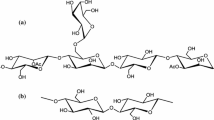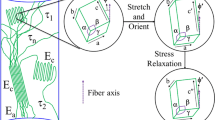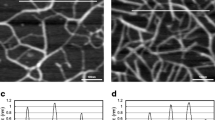Abstract
This study is an extension of previous work on cellulosics [(1994)Colloid Polym Sci 272: 284, 393] that showed that unusually good mechanical properties can be obtained by drying a swollen network of semirigid chains in a state of strain. This novel approach is applied in this investigation to gelatin, because of its attractive environmental characteristics but poor mechanical properties in the unmodified form. Since drawing of non-crosslinked gelatin is not practical, crosslinking by formaldehyde was used, followed by swelling, drawing and drying at fixed length. Mechanical tests were performed in static and dynamic modes. In this way improvements of Young's modulusE, and stress at breakσ b were determined as a function of gelatin concentration during drying. An increase inE andσ b up to 2–3 times, and in the dynamic modulusE′ up to 6 times, was obtained when the draw ratio λ reached 4–5, after whichE, E′, andσ b were found to decrease. Such behavior is explained by the highest orientation being achieved at λ=4–5, as proved by x-ray analysis. At λ=10–20 the orientation is lost due to relaxation of chain segments, which is preceded by partial destroying of the network structure (chemical and physical), possibly via chain scission, but probably mostly by the pulling out of chains from crystallites. In any case, the mechanical properties become poor again.
The improvements reported above were referred to the undrawn but crosslinked gelatin. Compared to the starting isotropic non-crosslinked material, the improvement is slightly higher. The observation that the improvements are less than those obtained for the cellulosics is explained by the coexistence of interpenetrating chemical and physical networks, which is typical of gelatin. This structural feature drastically reduces the orientability of the chains and the improvements that can be expected in the mechanical properties.
Similar content being viewed by others
References
Cifferi A, Ward IM (eds) (1979) Ultra high modulus polymers. Applied Science Publications, London, p 169
Peterlin A (1987) Colloid Polym Sci 265:357
Fischer L, Ruland W (1983) Colloid Polym Sci 201:717
Kunugi T, Ichirose Ch, Suzuki A (1986) J Appl Polym Sci 31:429
Goeschel U, Nitzche K (1985) Acta Polymerica 36:580
Petermann J, Gohil RM (1979) J Mater Sci 14:2260
Brody HJ (1983) Macromol Sci Phy B 22:19
Erman B, Bahar I, Kloczkowski A, Mark JE (1990) Macromolecules. 23:5335
Erman B, Bahar I, Kloczkowski A, Mark JE (1990) Macromolecules 23:5341
Yang Y, Kloczkowski A, Mark JE, Erman B, Bahar I (1994) Colloid Polym Sci 272:284
Mark JE, Yang Y, Kloczkowski A, Erman B, Bahar I (1994) Colloid Polym Sci 272:393
McEvoy H, Ross-Murphy S, Higgins JS (1989) Polym Commun 30:133
Ross PI (1987) Gelatin In: Mark HF, Bikales NM, Overberger CG, Menges G (eds) Encyclopedia of polymer science and engineering 7:488. John Wiley & Sons, New York
Davis P, Tabor BE (1963) J Polym Sci Part A 1:799
Ramachandran GN (1967) (ed) Treatise in collagen. Academic Press, Inc., New York
Fakirov S, Fakirov C, Fisher EW, Stamm M (1992) Polymer 33:3819
Stribeck N, Sapundjieva D, Apostolov AA, Dentchev Z, Zachmann HG, Stamm M, Fakirov S (1995) Makromolecules (submitted)
Zhao W, Kloczkowski A, Mark JE, Erman B, Bahar I (1995) ASC Meeting, Anaheim' 95
Author information
Authors and Affiliations
Rights and permissions
About this article
Cite this article
Fakirov, S., Sarac, Z., Anbar, T. et al. Mechanical properties and transition temperatures of cross-linked oriented gelatin. Colloid Polym Sci 274, 334–341 (1996). https://doi.org/10.1007/BF00654053
Received:
Accepted:
Issue Date:
DOI: https://doi.org/10.1007/BF00654053




